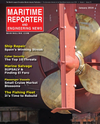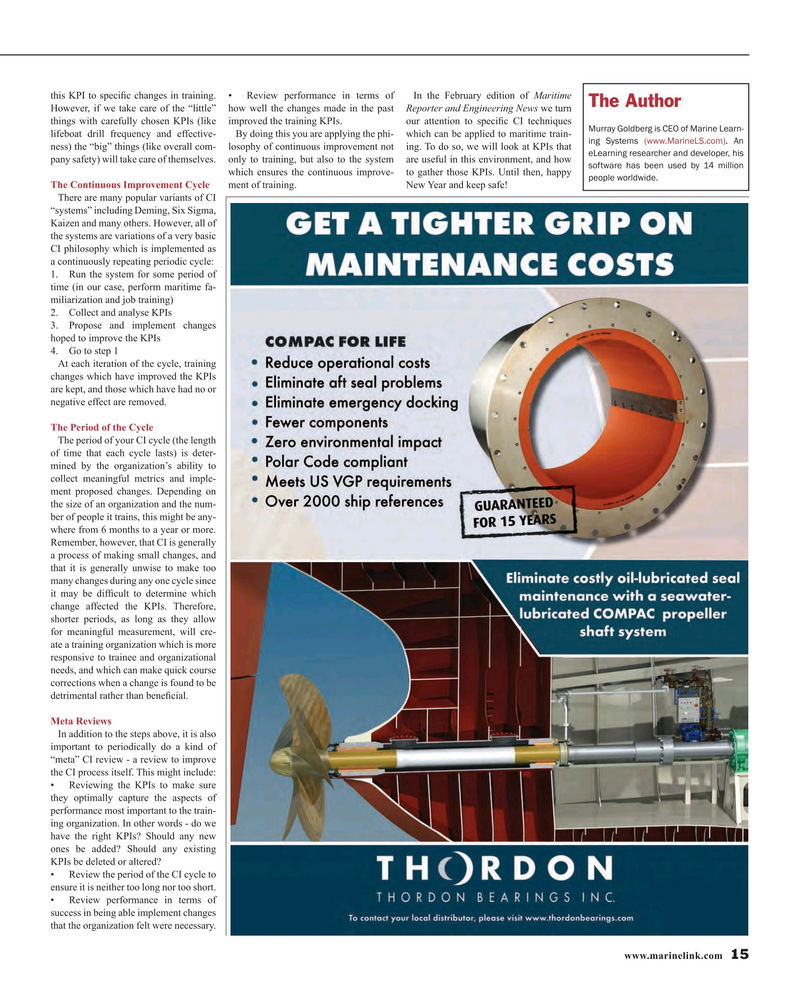
Page 15: of Maritime Reporter Magazine (January 2016)
Ship Repair & Conversion Edition
Read this page in Pdf, Flash or Html5 edition of January 2016 Maritime Reporter Magazine
this KPI to speci? c changes in training. • Review performance in terms of In the February edition of Maritime
The Author
However, if we take care of the “little” how well the changes made in the past Reporter and Engineering News we turn things with carefully chosen KPIs (like improved the training KPIs. our attention to speci? c CI techniques
Murray Goldberg is CEO of Marine Learn- lifeboat drill frequency and effective- By doing this you are applying the phi- which can be applied to maritime train- ing Systems (www.MarineLS.com). An ness) the “big” things (like overall com- losophy of continuous improvement not ing. To do so, we will look at KPIs that eLearning researcher and developer, his pany safety) will take care of themselves. only to training, but also to the system are useful in this environment, and how software has been used by 14 million which ensures the continuous improve- to gather those KPIs. Until then, happy people worldwide.
The Continuous Improvement Cycle ment of training. New Year and keep safe!
There are many popular variants of CI “systems” including Deming, Six Sigma,
Kaizen and many others. However, all of the systems are variations of a very basic
CI philosophy which is implemented as a continuously repeating periodic cycle: 1. Run the system for some period of time (in our case, perform maritime fa- miliarization and job training) 2. Collect and analyse KPIs 3. Propose and implement changes hoped to improve the KPIs 4. Go to step 1
At each iteration of the cycle, training changes which have improved the KPIs are kept, and those which have had no or negative effect are removed.
The Period of the Cycle
The period of your CI cycle (the length of time that each cycle lasts) is deter- mined by the organization’s ability to collect meaningful metrics and imple- ment proposed changes. Depending on the size of an organization and the num- ber of people it trains, this might be any- where from 6 months to a year or more.
Remember, however, that CI is generally a process of making small changes, and that it is generally unwise to make too many changes during any one cycle since it may be dif? cult to determine which change affected the KPIs. Therefore, shorter periods, as long as they allow for meaningful measurement, will cre- ate a training organization which is more responsive to trainee and organizational needs, and which can make quick course corrections when a change is found to be detrimental rather than bene? cial.
Meta Reviews
In addition to the steps above, it is also important to periodically do a kind of “meta” CI review - a review to improve the CI process itself. This might include: • Reviewing the KPIs to make sure they optimally capture the aspects of performance most important to the train- ing organization. In other words - do we have the right KPIs? Should any new ones be added? Should any existing
KPIs be deleted or altered?
• Review the period of the CI cycle to ensure it is neither too long nor too short.
• Review performance in terms of success in being able implement changes that the organization felt were necessary.
www.marinelink.com 15
MR #1 (10-17).indd 15 1/7/2016 10:47:51 AM

 14
14

 16
16
